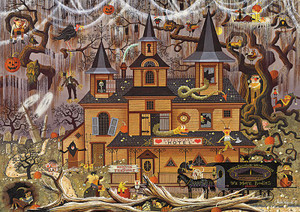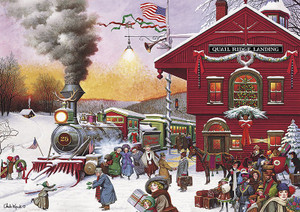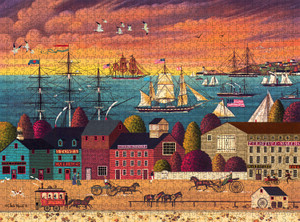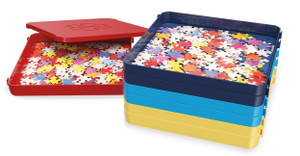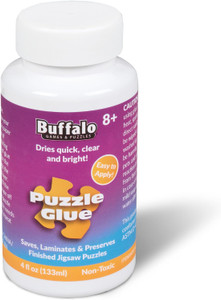Posted by Buffalo Games on Apr 5th 2022
How Long Does it Take to do a 1000 Piece Jigsaw Puzzle?
Putting jigsaw puzzles together is a relaxing activity for most people. But if you’re used to working 100 or 500 piece puzzles, taking on the challenge of 1000 piece puzzles can seem overwhelming. If your goal is to give yourself a fun challenge, not a headache, breaking the task into manageable steps will help.
How long it takes to complete 1000 piece jigsaw puzzles depends on several factors. Different puzzle designs can be more or less of a challenge. A puzzle with large, easily recognized images is easier to put together than one with repeating patterns and similar colors.
If you have a puzzle partner or two, the entire project can take as little as 3-4 hours. If you’re working alone and depending on the puzzle’s difficulty, it may take 12+ hours.
What Does Puzzling Teach You?
Many personal skills come into play when putting jigsaw puzzles together. The more naturally adept you are at these skills, the quicker you will work. As with almost everything, the more you practice, the better you will get.
Working with jigsaw puzzles can improve your:
- Problem-solving strategies
- Patience
- Collaborative skills
- Visual skills
- Ability to self-manage
- Cognitive skills
- Organizing strategies
- Communication skills
- Tactile skills
You gain all of this for the modest price of a 1000 piece jigsaw puzzle. Children and adults can apply the skills they learn through doing puzzles to other situations. Not only is it educational and valuable for skill-building, but doing puzzles is fun.
Don’t worry if you think it’s taking longer than it should. You’re not in a race! Enjoy yourself and the experience of building a beautiful scene while you improve all of the skills and abilities listed above.
To avoid becoming frustrated, follow these tips for completing 1000 piece jigsaw puzzles with ease.
Preparing a Workspace for Jigsaw Puzzles
There’s nothing more frustrating than having to move a puzzle when you’re only half done. A roll-up puzzle mat is an excellent investment if you don’t have enough flat spaces in your home to dedicate one for working puzzles. Even a rectangle of plywood or stiff foam board that you can move will do in a pinch.
Your 1000 piece jigsaw may be larger than you realize. Make sure you set aside a large workspace to accommodate all of the pieces, the box for reference, and some extra elbow room.
Ideally, there would be enough space to walk 360 degrees around your puzzle because sometimes, looking at the project from a different angle is helpful. But if that’s not possible, do your best with the space you have to work with.
Setting Up
Is there a right way to do a puzzle? Maybe not — but if time is a concern, there are faster and slower ways to get 1000 piece puzzles completed. A little preparation will help the entire project go more smoothly and quickly.
For the most efficient time, start by laying every piece flat on your work surface with the picture image up. The few minutes it takes to complete this step will save you much time and frustration as you begin linking pieces together.
Sort all of the pieces by pattern and color. Moving them into groups with similar pieces gives you a series of more manageable tasks and reduces the number of options you need to try before finding pieces that fit.
As you’re sorting, separate all of the edge pieces—those with one or two flat sides—for building the frame later.
Build the Frame
Completing the puzzle frame first helps you define the workspace and better visualize the size of each section. It also gives you the satisfaction of completing one crucial step. Once the frame is built, you can begin working through the smaller piles and finding recognizable shapes and colors such as:
- The skyline
- Text or printed signs
- Faces and other distinguishable pieces
- Windows, chimneys, doors, and roads
To stay organized and complete your 1000 piece puzzles in the shortest amount of time, keep “hard” sections like a monotone sky or bodies of water until last. Once you’ve got most of the puzzle put together, completing those more challenging sections will be easier because you have a smaller pool of pieces from which to choose.
Build Up (or Down or Out)
Once you have a sizable section finished, such as an entire head/face or a significant portion of a building, continue building on that success. Put a few more pieces to the sides, top, and bottom before moving on to something else.
If you want to complete jigsaw puzzles quickly, develop the patience to build several large sections instead of moving around the entire puzzle and placing a random piece here or there.
It’s natural to start getting bored with one color scheme or image after a while but stick with it as long as you can. If you feel you’re getting tunnel vision and can no longer focus, give your eyes and brain a break.
Walking away for a few moments is more productive than working on several small sections. Each time you move your focus to a new area, your brain and eyes have to readjust to new colors and images.
Bring It Home!
Oh, boy, you’re almost done! Now that many large sections or images are built, it’s time to fill in the background. This is where the above strategies will pay off. You’ve whittled away at your piles, and it will be easier to connect the main images.
More Fun with 1000 Piece Jigsaw Puzzles
Doing larger puzzles is fun, but don’t think you have to move up to 1500 or 2000 pieces to keep yourself challenged. Once you’ve mastered the organizational skills to handle 1000 piece puzzles, look for more challenging images.
Mountain landscapes with large swaths of sky or unrealistic images that your eyes aren’t used to looking at can be incredibly challenging to complete.
Many people feel that they don’t notice how much time has gone by when they are profoundly enjoying a puzzle. That’s part of what makes doing puzzles so relaxing. Don’t worry that you’re taking too long on your jigsaw puzzles. Enjoying yourself—not finishing quickly—is the ultimate goal.





